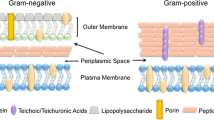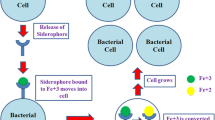Abstract
The objective of this work is to detect the mode of damage caused by Cr(III), one of the widely used industrial pollutant on Bacillus subtilis—industrial strain 168 and Escherichia coli MTCC 40. Bioassays are very sensitive, precise, economical and rapid for detecting early stages of pollution. The detrimental effect of trivalent chromium becomes clear from the growth profile and growth inhibition studies. Mode of action of damage by trivalent chromium in bacterial model was found to be oxidative, as chromium is one of the redox active metals. The generation of reactive oxygen species (ROS) resulted in membrane damage which in turn had a detrimental effect on the membrane proteins as well as the DNA. The structural changes in the SEM and AFM images clearly reveals the damage caused by Cr(III) to the test bacterial models. Trivalent chromium causes greater DNA, protein and membrane damage in case of E. coli than B. subtilis. Membrane damage caused by ROS becomes evident from the production of Thiobarbituric acid reactive substances (TBARs) as the mechanism of killing followed by DNA damage and the production of elevated levels of stress proteins known as extracellular cellular proteins.







Similar content being viewed by others
References
Arakawa H, Ahmed R, Naoui M, Riahi HAT (2000) A comparative study of calf thymus DNA binding to Cr(III) and Cr(VI) ions. Evidence for the guanine N-7-chromium-phosphate chelate formation. J Biol Chem 275:10150–10153
Arokiyaraj S, Arasu MV, Vincent S, Prakash NU, Choi SH, Oh YK, Choi KC, Kim KH (2013) Rapid green synthesis of silver nanoparticles from Chrysanthemum indicum L and its antibacterial and cytotoxic effects: an in vitro study. Int J Nanomed 9:379–388
Bai RS, Abraham TE (2001) Biosorption of chromium(VI) from aqueous solution by Rhizopus nigricans. Bioresour Technol 79:891–893
Beveridge TJ (1999) Structures of gram-negative cell walls and their derived membrane vesicles. J Bacteriol 181:4725–4733
Bovykin BA, Kylyvnyk KE, Zegzhda AD (1999) Influence of chromium (III) ions and the chromium cysteine complex on bilayer lipid membranes. Biophysics 44:454–457
Bradford MM (1976) A rapid and sensitive method for the quantitation of microgram quantities of protein utilizing the principle of protein-dye binding. Anal Biochem 72:248–254
Chourey K, Thompson MR, Morrell-Falvey J, VerBerkmoes NC, Brown SD, Shah M, Zhou J, Doktycz M, Hettich RL, Thompson DK (2006) Global molecular and morphological effects of 24-hour chromium(VI) exposure on Shewanella oneidensis MR-1. Appl Environ Microbiol 72:6331–6344
Cui Y, Kim SH, Kim H, Yeom Y, Ko K, Park W, Park S (2012) AFM probing the mechanism of synergistic effects of the green tea polyphenol (–)-epigallocatechin-3-gallate (EGCG) with cefotaxime against extended-spectrum beta-lactamase (ESBL) producing Escherichia coli. PLOS One 7:e48880
Dwivedi S, Wahab R, Khan F, Mishra YK, Musarrat J, Al-Khedhairy AA (2014) Reactive oxygen species mediated bacterial biofilm inhibition via zinc oxide nanoparticles and their statistical determination. PLOS One 9:e111289
Fai PB, Grant A (2010) An assessment of the potential of the microbial assay for risk assessment (MARA) for ecotoxicological testing. Ecotoxicol 19:1626–1633
Folch J, Lees M, Sloane-Stanley GH (1957) A simple method for the isolation and purification of total lipides from animal tissues. J Biol Chem 226:497–509
Guerrere P, Collao B, Alvarez R, Salinas H, Morales EH, Calderon IL, Saavedra CP, Gil F (2013) Salmonella enterica serovar Typhimurium BaeSR two-component system positively regulates sodA in response to ciprofloxacin. Microbiol 159:2049–2057
Hwan KS, Lee HS, Ryu DS, Choi SJ, Lee DS (2011) Antibacterial activity of silver-nanoparticles against Staphylococcus aureus and Escherichia coli. Korean J Microbiol Biotechnol 39:77–85
Ibrahim HR, Sugimoto Y, Aoki T (2000) Ovotransferrin antimicrobial peptide (OTAP-92) kills bacteria through a membrane damage mechanism. Biochim Biophys Acta 1523:196–205
Jomova K, Valko M (2011) Advances in metal-induced oxidative stress and human disease. Toxicology 283:65–87
Karunakaran E, Biggs CA (2011) Mechanisms of Bacillus cereus biofilm formation: an investigation of the physicochemical characteristics of cell surfaces and extracellular proteins. Appl Microbiol Biotechnol 89:1161–1175
Khan AL, Ullah I, Hussain J, Kang SM, Al-Harrasi A, Al-Rawahi A, Lee IJ (2014) Regulations of essential amino acids and proteomics of bacterial endophytes Sphingomonas sp. Lk11 during Cadmium uptake. Environ Toxicol doi:10.1002/tox.22100
Ninganagouda S, Rathod V, Singh D, Hiremath J, Singh AK, Mathew J, Haq MU (2014)Growth kinetics and mechanistic action of reactive oxygen species released by silver nanoparticles from Aspergillus niger on Escherichia coli. Biomed Res Int Article ID 753419
Plaper A, Brinovec SJ, Premzl A, Kos J, Raspor P (2002) Genotoxicity of trivalent chromium in bacterial cells. Possible effects on DNA topology. Chem Res Toxicol 15:943–949
Ramirez-Diaz M, Diaz-Perez C, Vargas E, Riveros-Rosas H, Campos-Garcia J, Cervantes C (2008) Mechanisms of bacterial resistance to chromium compounds. Biometals 21:321–332
Sauriasari R, Wang DH, Takemura Y, Tsutsui K, Masuoka N, Sano K, Horita M, Wang BL, Ogino K (2007) Cytotoxicity of lawsone and cytoprotective activity of antioxidants in catalase mutant Escherichia coli. Toxicology 235:103–111
Sheikh C, Houssain MS, Easmin MS, Islam MS, Houssain MA, Rashid M (2004) New coordination complexes of chromium as cytotoxic and antimicrobial agents. Pak J Biol Sci 7:335–339
Shen H, Wang Y (1994) Biological Reduction of Chromium by E. coli. J Environ Eng 120:560–572
Shrivastava HY, Ravikumar T, Shanmugasundaram N, Babu M, Nair BU (2005) Cytotoxicity studies of chromium(III) complexes on human dermal fibroblasts. Free Radic Biol Med 38:58–69
Stohs SJ, Bagchi D (1995) Oxidative mechanisms in the toxicity of metal ions. Free Radic Biol Med 18:321–336
Tavares AF, Teixeira M, Romao CC, Seixas JD, Nobre LS, Saraiv LM (2011) Reactive oxygen species mediate bactericidal killing elicited by carbon monoxide-releasing molecules. J Biol Chem 286:26708–26717
Ward TL, Berrio LF, Southern LL, Fernandez JM, Thompson DL (1994) In-vivo and in-vitro evaluation of chromium tripicolinate on insulin binding in pig liver cell plasma membranes. FASEB J 8:10000194–10000194
Acknowledgements
The authors thank Dr. Aruna Dhathathreyan, Head, Biophysics department, CLRI for guiding to carry out liposome work and AFM imaging. AF thanks CSIR for providing senior research fellowship (SRF), Grant No – 31/6(388)/2013-EMR-I.
Author information
Authors and Affiliations
Corresponding author
Additional information
Communicated by Erko Stackebrandt.
Rights and permissions
About this article
Cite this article
Fathima, A., Rao, J.R. Is Cr(III) toxic to bacteria: toxicity studies using Bacillus subtilis and Escherichia coli as model organism. Arch Microbiol 200, 453–462 (2018). https://doi.org/10.1007/s00203-017-1444-4
Received:
Revised:
Accepted:
Published:
Issue Date:
DOI: https://doi.org/10.1007/s00203-017-1444-4




